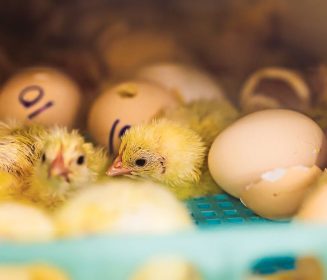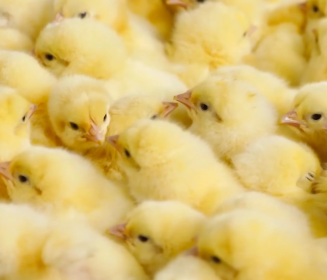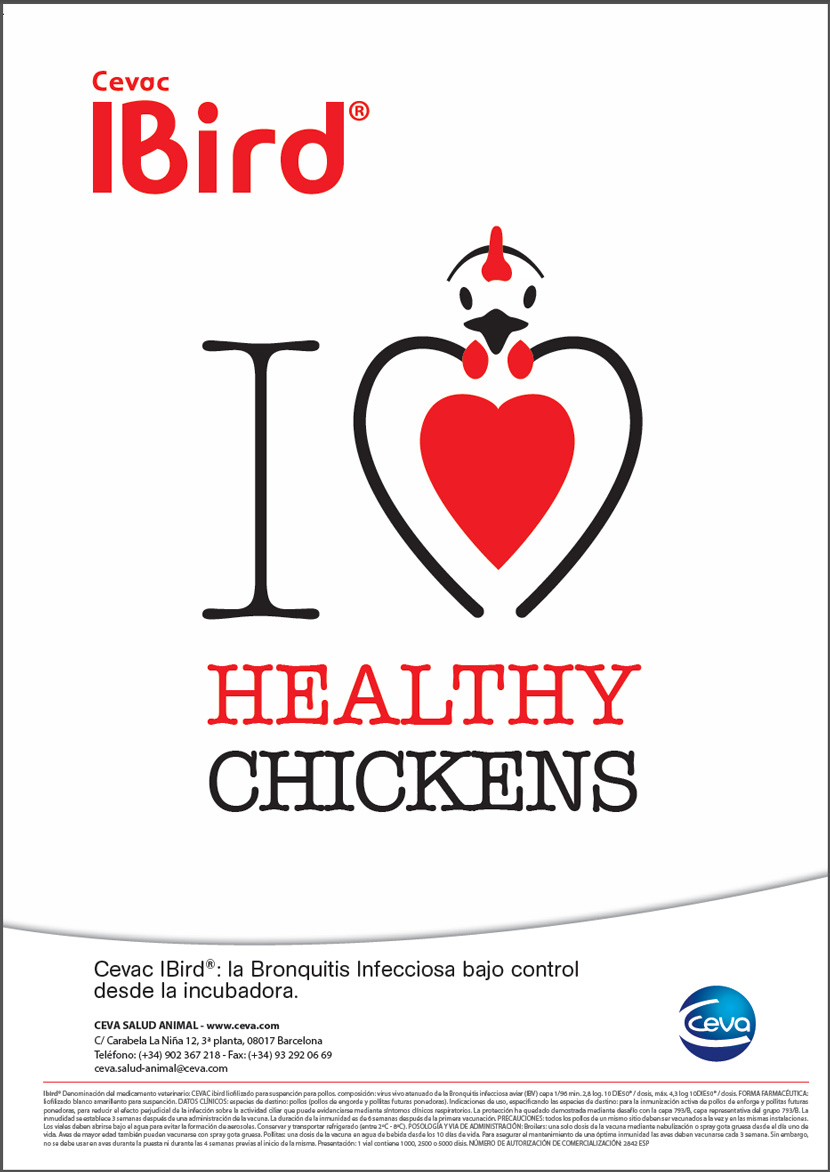
14 Nov 2019
Part I. Frequent problems in Hatcheries
El trabajo de la persona que realiza y analiza las aperturas comienza por saber qué porcentaje excede la “normalidad”. Esa normalidad se obtiene con información de la casa genética y realizando aperturas de nacimientos que cumplieron las expectativas fijadas para la edad de las reproductoras y el almacenamiento de los huevos y contra ellas se comparara los resultados obtenidos en nacimientos futuros.
Content available at:
Español (Spanish)
By Juan Carlos López,
MVZ MVsc PhD
Hendrix Genetics
It is important to start out from the assumption that even though the birth rate of a batch is very good and the quality of birds is satisfactory, you may always find abnormal embryos in the trays.
Even though a batch is performing well, it must always be monitored. Egg opening is recommended of those eggs which remain in the tray of all batches at least every two weeks (Mauldin 2009). Sometimes, finding the cause of lower birth rates is difficult since its origin is not always found in the hatchery.
The problem might have been originated in the feed factory or is attributable to the breeder’s health condition, their management, egg storage and transport etc. Additionally, an abnormality may be caused by several factors (e.g. temperature and/or humidity). The following table shows some frequently observed problems, their causes, possible corrective measures and some references.
The goal of every hatchery is to produce, from fertile eggs, the largest amount of “good” quality birds. One of the most powerful tools which helps attaining said goal is to carry out an analysis of the eggs which remain in the trays.
Clear eggs, without embryo development (infertile)
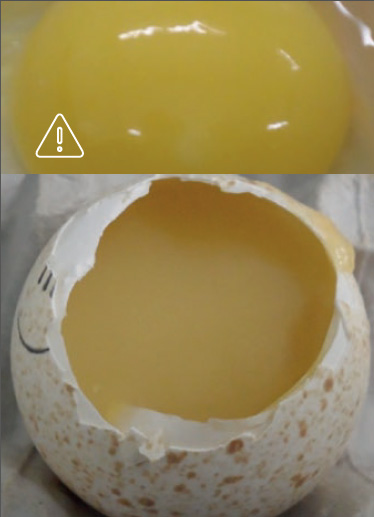
Corrective measures:
Continue after advertising.
Replace males
Possible cause: inadequate nutrition or insufficient water intake
Corrective measures: Check nutrients in portions and water temperature
Possible cause: Insemination problems
Corrective measures: Check semen techniques and management
Possible cause: Egg damage due to extreme environmental conditions
Corrective measures: Pick up the eggs frequently from the nests and not leaving them exposed to extreme temperatures
Possible cause: Eggs stored for too long or incorrectly stored
Corrective measures: Check temperature 12-14°C (Wilson 1991; Fasenko et al. 1992), turn the eggs during storage at an angle of 45°, turn around eggs if stored for an prolonged period (Elibol and Brake 2008)
Possible cause: Improper Fumigation or disinfection
Corrective measures: Check fumigation or disinfection protocols. Do not fumigate during the first week in hatchers (Hodgetts 1987). Do not pack eggs during the first 24 hours after fumigating with formaldehyde (Proudfoot and Stewart 1970)
Possible cause: Bird disease
Corrective measures: Check the bird health condition since some of them (sic)
Many dead eggs in early stage
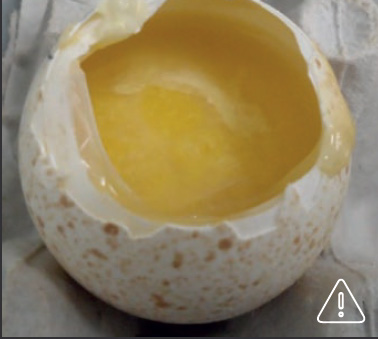
Corrective measures: Check storage temperature (12-14°C, Wilson 1991; Fasenko et al. 1992), pick up frequently. Turning during prolonged storage.
Possible causes: Transportation
Corrective measures: Eggs must always be transported at a temperature equal to or lower than the farm’s temperature. Avoid abrupt movements.
Possible causes: Very high or low temperature during the first days of incubation
Corrective measures: Check and/or calibrate thermometers. Embryo’s temperature must be as closer as possible to 37.7 ºC (Lourens et al. 2005).
Possible causes: Contamination
Corrective measures: Check collection and disinfection practices of nests in the farms. Check product concentration for disinfection of eggs.
Possible causes: Insufficient embryo development at oviposition
Corrective measures: Pre-incubate eggs so that all embryos reach the same development stage and better survive storage (Fasenko et al. 2001).
Possible causes: Severe nutritional deficiencies
Corrective measures: Check vitamin and mineral levels, e.g.: biotin, Vitamin A, copper, Vitamin E, boron, pantothenic acid, or linoleic acid.
Possible causes: Improper fumigation or disinfection
Corrective measures: Check dosage and exposure time.
Possible causes: Ventilation
Corrective measures: Check that all CO2 levels do not exceed 1% during the first 4 days (Taylor et al. 1956).
Possible causes: Turning problems
Corrective measures: Check frequency (from 24 to 96 times/day) and turning angle 45˚ (Cutchin et al. 2007).
Many dead embryos in intermediate stages

Corrective measures: Check deficiency in riboflavin, vitamin B12, biotin, niacin, pantothenic acid, phosphorus, boron or linoleic acid
Possible cause: Extreme temperatures or humidity, turning or ventilation problems
Corrective measures: Check and/or calibrate thermometers. Measure embryo temperature (37.7 ºC) and humidity loss. Check turning frequency and angle (Elibol and Brake 2006)
Possible cause: Contamination
Corrective measures: Check cleaning and disinfection programs in farms and hatcheries. Growth monitoring in culture media of pathogen microorganisms
Possible cause: Lethal genes
Full-term embryos with yolk sacs and/or unabsorbed residual albumen which do not pip
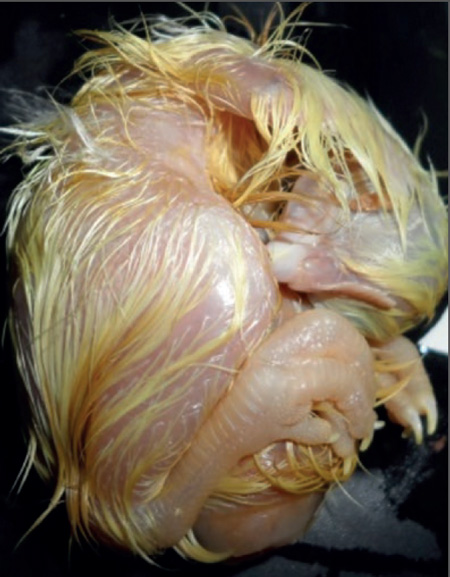
Corrective measures: Check turning frequency (at least 24 times per day) and angle (45°)
Possible causes: Temperature
Corrective measures: Check if temperature was extremely low in incubators or very high in hatchers
Possible causes: Humidity
Corrective measures: Check if humidity was very high during incubation or in hatchers. Eggs must lose about 12% of their weight at transfer. Chicks must weigh from 67 to 70% of the original weight of the eggs
Possible causes: Ventilation
Corrective measures: Verify whether there is sufficient or excessive air intake
Possible causes: Prolonged storage
Corrective measures: Reduce storage time and verify conditions thereof
Possible causes: Excessive cooling after transfer
Corrective measures: Check temperature of transfer room and transfer time
Possible causes: Breeder disease
Corrective measures: Check biosecurity and vaccination plans
Possible causes: Accidents during embryological development
Possible causes: Heredity
Pipped eggs. Full-term embryo, alive or dead in shell.
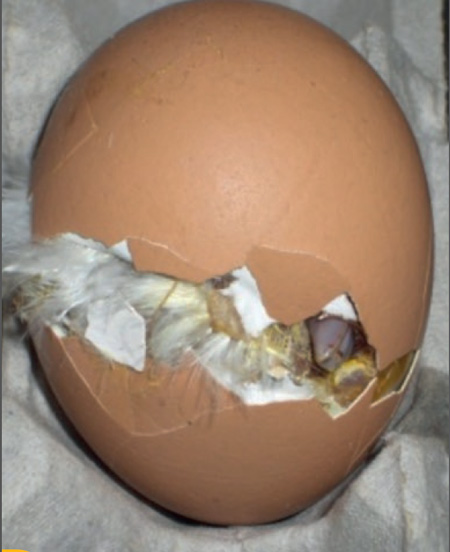
Corrective measures: Check humidity loss during transfer which must be about 12% and bird/egg weight ratio (67-70%)
Possible causes: Very high temperature during hatching
Corrective measures: Check hatcher profiles. Calibrate thermometers
Possible causes: Very low temperature during prolonged periods
Corrective measures: Check and/or calibrate thermometers. Measure embryo temperature. Carry out the hatching window
Possible causes: Ventilation failure, excessive fumigation during hatching
Corrective measures: Check carbon dioxide levels and disinfection practices.
Possible causes: Inadequate turning
Corrective measures: Check turning frequency and angle
Possible causes: Transfer
Corrective measures: Reduce speed during the process
Possible causes: Prolonged storage
Corrective measures: Check temperature, turn eggs, turn eggs around (Elibol and Brake 2008)
Possible causes: Fumigation
Corrective measures: Excessive fumigation during pipping. An example is the use of formaldehyde (Fauziah et al., 1996)
Possible causes: Eggs upside down
Corrective measures: Check collection and management in farms (Bauer et al. 1990)
Many birds pipping (high) but they are stuck in the shells
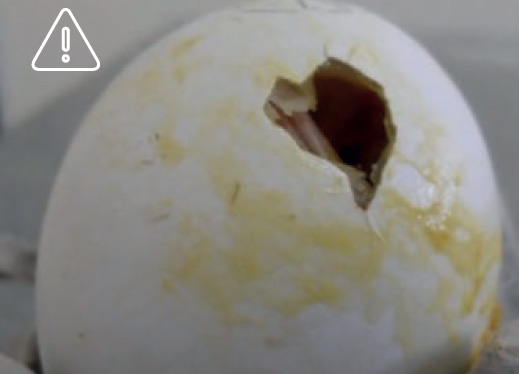
Corrective measures: Monitor weight loss during transfer and when birds are born. Check embryo temperature (100°F)
Possible causes: Low humidity in hatchers
Corrective measures: Increase humidity during pipping
Very small air cell, irregular pipping, membranes incompletely cut, red hocks, edematous chicks, unabsorbed albumen, yolk sac incompletely retracted, egg weight loss much lower than <10%

Corrective measures: Check humidity loss during transfer (about 12%)
Possible causes: Very thick shells
Corrective measures: Check incubation profiles
Possible causes: Very low temperature during incubation
Corrective measures: Check and/or calibrate thermometers. Measure embryo temperature (37.7 ºC)
Premature hatching, bloody navels.
Possible causes: Incubator or hatcher temperature extremely high.
Corrective measures: Check and/or calibrate thermometers. Measure embryo temperature (37.7 ºC)
Unhealed navel
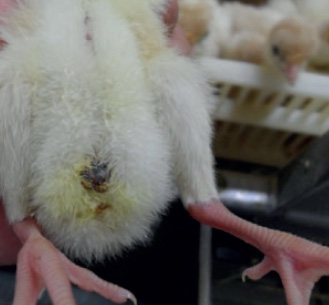
Corrective measures: Check profile temperature. Embryos develop too quickly and yolk sac penetration cannot be synchronized (Leksrisompong et al. 2007). Check and calibrate thermometers
Umbilical cord
 Possible causes: High humidity in hatchers.
Possible causes: High humidity in hatchers.
Corrective measures: Check humidity profiles in hatchers. The umbilical blood vessel does not dry and fall as it normally does.
Malformations
Possible causes: Transportation
Corrective measures: Avoid abrupt movements
Possible causes: Nutritional causes
Corrective measures: Check deficiencies, e.g.: biotin, riboflavin, zinc, manganese
Possible causes: High or low temperatures during incubation
Corrective measures: Check and/or calibrate thermometers. Measure embryo temperature
Possible causes: Ventilation
Corrective measures: Check ventilation profiles
Possible causes: Turning
Corrective measures: Check turning frequency and angle
Possible causes: Egg position in trays
Corrective measures: Check egg collection and their position in trays
Malposition. Normal position: embryo located along the axis of egg; head in large end of egg, head to the right and under right wing; beak toward air cell
 Possible causes: Eggs set small end up or without giving time for rest.
Possible causes: Eggs set small end up or without giving time for rest.
Corrective measures: Check egg position in trays
Possible causes: High temperature in hatchers
Corrective measures: Check and/or calibrate thermometers. Measure embryo temperature (French 2000)
Possible causes: Inadequate turning
Corrective measures: Check angle (45°; Elibol and Brake 2006) frequency (at least 24 times, Wilson 1991). First week (Elibol and Brake 2004).
Possible causes: High humidity
Corrective measures: Check humidity profiles and weight loss of eggs
Possible causes: High percentage of round-shaped eggs or very large eggs.
Corrective measures: Check egg selection
Possible causes: Nutritional deficiencies
Corrective measures: Check vitamin A, B12 and linoleic acid levels
This article makes reference to the first part of the talk given by the author in the International Technical Conference on Reproduction and Incubation of aviNews.
The second part of the talk will be published in the next edition of the magazine aviNews, wherein we’ll continue showing some of the frequently seen problems mainly affecting malformations in terminal phase embryos and newborn chick abnormalities. We will revise causes, possible corrective measures and some references.







